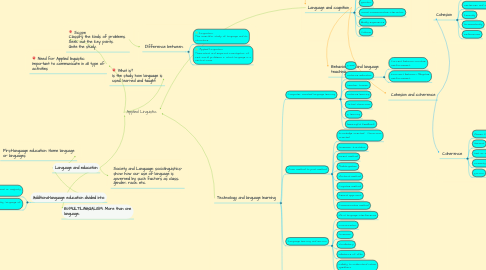
1. Language and education
2. Society and Language: sociolinguistics– show how our use of language is governed by such factors as class, gender, race, etc.
3. BI/MULTILINGUALISM: More than one language,
4. Additional-language education divided into:
4.1. SECOND-LANGUAGE official or majority language.
4.2. FOREIGN LANGUAGE: language of another country
5. First-language education: Home language or languages
6. Need for Applied linguistic: Important to communicate in all type of activities
7. What is? Is the study how language is used, learned and taught.
8. Scope Classify the kinds of problems. Seek out the key points. Unite the study.
9. Difference between:
9.1. Linguistics: The scientific study of language and its structure
9.2. Applied Linguistics Theoretical and empirical investigation of real world problems in which language is a central issue.
10. Language and cognition
10.1. ACTION
10.2. PERCEPTION
10.3. Emotion
10.4. Social-communicative interaction
10.5. Bodily experience
10.6. Culture
11. Cohesion and coherence
12. Coherence
12.1. Fewer formal
12.2. General
12.3. text as a whole
12.4. Primarily semantic relationship
12.5. Errors
13. Cohesion
13.1. Formal
13.2. Sentences and within sentences
13.3. Lexically
13.4. Grammatically
13.5. References
14. Behaviourisim and language teaching:
14.1. Correct behavior=Positive reinforcement
14.2. Incorrect behavior= Negative reinforcement
15. Pragmatics and language teaching
15.1. Language external
15.2. Communication
15.3. What speakers mean?
15.4. Human expressions
15.5. Use of language
16. Technology and language learning
16.1. Computer assisted language learning
16.1.1. E-mail
16.1.2. Distance education
16.1.3. teacher traiiner
16.1.4. Distance learning
16.1.5. Virtual classroom
16.1.6. E.-learning
16.1.7. Meaningful feedback
16.2. From method to post-method
16.2.1. Knowledge oriented - Classroom oriented
16.2.2. Grammar translation
16.2.3. Direct method
16.2.4. Audiolingualism
16.2.5. Funtional method
16.2.6. Cognitive method
16.2.7. Lexical approach
16.2.8. Communicative method
16.3. Language learning and errors
16.3.1. 1First language interference
16.3.2. Pronunciation
16.3.3. Grammar
16.3.4. Vocabulary
16.3.5. Imbalance of skills
16.3.6. Inability to understand native speakers
16.4. Vocabulary assessments
16.4.1. digital program student
16.4.2. Take a quiz or test
16.4.3. Is hard on students
16.4.4. Teachers can assign assessments virtually and grading is done automatically by the program.
16.4.5. The questions can be automatically changed based on teacher preference.
